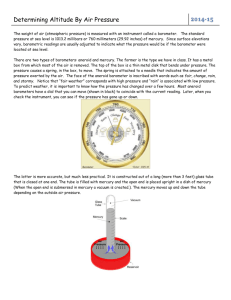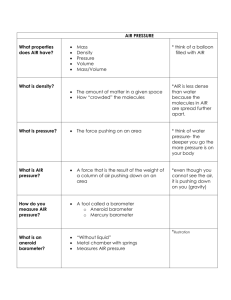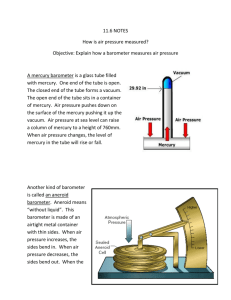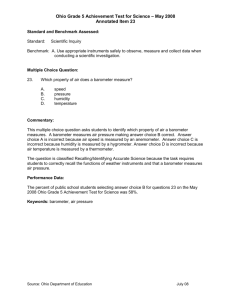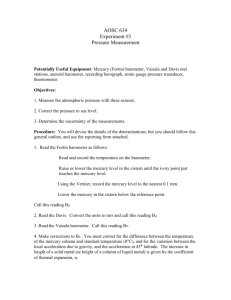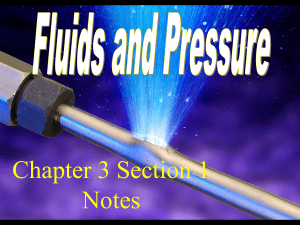L11 - Fluid Pressure Student
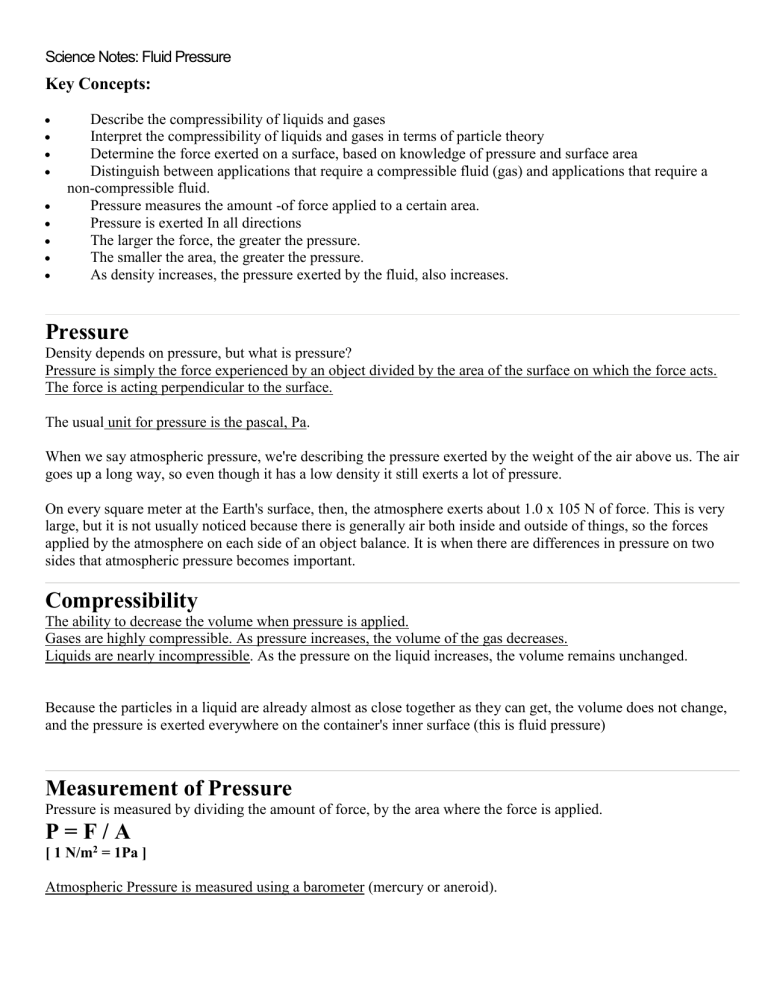
Science Notes: Fluid Pressure
Key Concepts:
Describe the compressibility of liquids and gases
Interpret the compressibility of liquids and gases in terms of particle theory
Determine the force exerted on a surface, based on knowledge of pressure and surface area
Distinguish between applications that require a compressible fluid (gas) and applications that require a non-compressible fluid.
Pressure measures the amount -of force applied to a certain area.
Pressure is exerted In all directions
The larger the force, the greater the pressure.
The smaller the area, the greater the pressure.
As density increases, the pressure exerted by the fluid, also increases.
Pressure
Density depends on pressure, but what is pressure?
Pressure is simply the force experienced by an object divided by the area of the surface on which the force acts.
The force is acting perpendicular to the surface.
The usual unit for pressure is the pascal, Pa.
When we say atmospheric pressure, we're describing the pressure exerted by the weight of the air above us. The air goes up a long way, so even though it has a low density it still exerts a lot of pressure.
On every square meter at the Earth's surface, then, the atmosphere exerts about 1.0 x 105 N of force. This is very large, but it is not usually noticed because there is generally air both inside and outside of things, so the forces applied by the atmosphere on each side of an object balance. It is when there are differences in pressure on two sides that atmospheric pressure becomes important.
Compressibility
The ability to decrease the volume when pressure is applied.
Gases are highly compressible. As pressure increases, the volume of the gas decreases.
Liquids are nearly incompressible. As the pressure on the liquid increases, the volume remains unchanged.
Because the particles in a liquid are already almost as close together as they can get, the volume does not change, and the pressure is exerted everywhere on the container's inner surface (this is fluid pressure)
Measurement of Pressure
Pressure is measured by dividing the amount of force, by the area where the force is applied.
P = F / A
[ 1 N/m 2 = 1Pa ]
Atmospheric Pressure is measured using a barometer (mercury or aneroid).
How Do We Measure the Pressure of Air?
Air pressure is most often measured with a barometer. There are several different types:
BAROMETERS
A barometer is an instrument used to measure air (or barometric) pressure. Essentially a barometer measures the weight of a column of air extending from the instrument up to the top of the atmosphere. Barometers are calibrated with a variety of scales, such as inches of mercury or millibars.
Several types of barometers have been perfected and are sufficiently sensitive to permit measurement of the subtle changes in barometric pressure which affect the weather. As a result, meteorologists use barometers to measure the horizontal pressure variations at specified times in order to locate high and low pressure systems.
Two types of commonly used barometers are the mercury and aneroid barometers. A specially designed barometer used to record the air pressure with time is called a barograph.
MERCURY BAROMETER
The mercury barometer is one of the early weather instruments, and was invented by Evangelista Torricelli in
1642. Because his instrument is so simple and fundamental in design, the mercury barometer is still used today as the standard air pressure indicator. It consists of a glass tube closed at one end and filled with liquid mercury. A meter long glass tube of uniform internal diameter is needed.
Torricelli wondered how water pumps raise water more than about 33 feet (10 meters) from its source. Vacuum pumps, in which a piston was raised in a pipe to suck water upward, were used then. He showed that air exerts a pressure on the water. Whenever that pressure is lowered in one place, it was pushed into that place by the higher pressure exerted elsewhere on the water. This principle is applied when a straw is used to drink water. Sucking on the straw lowers the internal air pressure. The greater pressure pushing down on the water in the glass forces some of the water to move up into the straw.
Torricelli's barometer and the principles that it uncovered were soon accepted by other scientists. The understanding of air pressure and vacuums gained from the barometer was important in the development of the steam engine, one of the main inventions that signaled the beginning of the Industrial Revolution.
Because the height and density of the liquid in the column are known, the weight of the liquid column, and then the pressure exerted by that liquid column can be computed. Changes in the atmospheric pressure exerted upon the surface of the mercury in the open reservoir are reflected by changes of the height of the mercury in the evacuated column. The greater the atmospheric pressure, the higher the mercury column ascends in the evacuated tube.
ANEROID BAROMETER
Because mercury barometers are expensive and cumbersome, another type of barometer is used. This barometer is called an aneroid (or "fluidless") barometer. The aneroid barometer is a spring balance, with a sealed, partially evacuated canister with flexible walls.
Measurement of air pressure by an aneroid barometer involves balancing the weight of the atmosphere against a known spring force exerted upon the walls of the chamber. Increasing the outside air pressure collapses the walls of the canister slightly, because the pressure on the outside wall of the canister wall is greater than the pressure on the inner wall.
While not as accurate as the mercury barometer, the aneroid barometer is more widely used because it is compact, portable, rugged, relatively cheap and it can be adapted to become a recording instrument, or a barograph.
BAROGRAPH
The barograph is used to permanently record barometric changes. A barograph is a recording aneroid barometer, where the coupling mechanism is linked to a recording pen which produces a continuous record of pressure changes.
Pascal's principle
Pressure applied to an enclosed fluid is transmitted undiminished to every part of the fluid, as well as to the walls of the container.
Pascal's principle can be used to explain how hydraulic systems work. A common example of such a system is the lift used to raise a car off the ground so it can be repaired at a garage.

